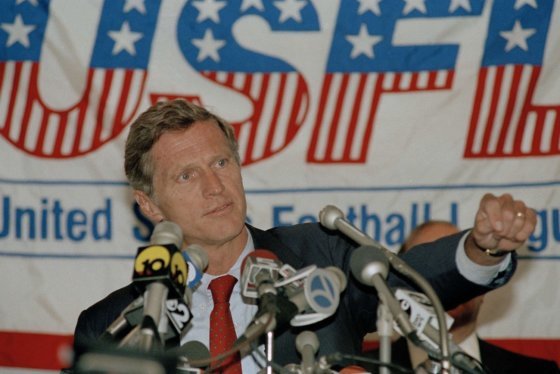No, you’re not dreaming. It’s late February, and every Saturday and Sunday, there is football being played on your television.
Spring football has been tried before in America, but early indications are cautiously optimistic that the new Alliance of American Football may have struck the right balance to make it work.
Dinn Mann worked for MLB Advanced Media for 17 years, starting on the ground floor before it became the behemoth it is today. Now he finds himself back at the beginning of a new startup as the head of content and marketing for the AAF, where the rules and structures are still being formed on the fly and where the path from innovation to actualization faces far fewer barriers.
“The exciting thing to me was it was this untrampled snow of a brand-new league, no territorialism between offline and online, no politics between the teams and league,” he told WTOP.
The AAF seems intent on learning from and avoiding repeating those mistakes made by past attempts at professional spring football. The league got its first bit of good news opening weekend, when their debut game drew more than 3 million viewers, beating the Houston Rockets-Oklahoma City Thunder NBA game during the same time slot in the ratings.
Any new league will have its bumps, though, and it’s been an eventful two weeks, to say the least. The Athletic reported the league received a “much-needed” cash infusion this week in order to make payroll, inevitably invoking memories of bankruptcies of past football leagues. One sports book sprung to set lines and take bets on whether the league would make it to its second season, or even finish its first.
But the AAF received a $250 million cash infusion from Carolina Hurricanes owner Tom Dundon this week — one which the league said was not connected to players receiving late checks, which it blamed on a payroll snafu, not any measure of insolvency. Regardless of which side of the story you believe, the league now has financial backing to match the early enthusiasm.
This can all function this way because there are not eight individual ownership groups in the AAF — each team is centrally owned by the league. This allows them to pay everyone equally, on three-year, non-guaranteed contracts worth a total of $250,000 each. That means no rogue, out-of-control free agent spending wars that can drive franchises off the rails.
“They were smart to have the teams all centralized,” author of USFL chronicle “Football for a Buck” Jeff Pearlman told WTOP. “There are tons of markets that are very much like successful USFL markets.”
Only two of the eight teams share a market with the NFL — Atlanta and Arizona (the team plays in Tempe). The other six are in mostly warm-weather cities with enough interest to be intriguing: Birmingham, Memphis, Orlando, Salt Lake City, San Antonio and San Diego.

They’ve also got the television contracts. AAF games will appear on CBS, NFL Network, CBS Sports Network, TNT and BR Live. On the Sports Media with Richard Deitsch podcast Thursday, Sports Business Daily media reporter John Ourand said those contracts involve some money directly coming from the networks to the league, coupled with a revenue-sharing model based on advertising sold. But the wide range of channels reflects a specific approach from the league’s perspective.
“You need to go where football fans are, and you need to go where potential football fans are,” said Mann.
If the broadcasts themselves have an inherent familiarity to them, that’s no accident — veteran NFL producer Mark Teitelman was brought on to curate a similar feel, albeit with added camera angles and audio sources.
“There was the authenticity of their production quality, which was so familiar to people,” Mann said.
Still — the actual football had to be good enough for fans to care. Was there enough talent to make a compelling product?
After all, D.C.-area football fans may best know the AAF as the league associated with Washington quarterback Josh Johnson. Before Johnson found himself under center, cleaning up the last couple of games of the Burgundy & Gold’s 2018 campaign, he had been the top overall pick in the AAF’s inaugural draft for the San Diego Fleet. But when the NFL came calling, there was no question on either side that he would take the opportunity — to do anything else would be antithetical to the league’s purpose.
“He was really proof immediately that we had a credible working relationship with the NFL,” said Mann of Johnson. “That’s what the league’s here for — to give guys a chance to get reps at full speed.”
That’s one of the reasons why even though it may be surprising to see the games airing on NFL Network, it shouldn’t be. Unlike other football leagues from the XFL back to the USFL, the AAF isn’t presenting itself as competition to the NFL. It’s happy to live in symbiosis.
The AAF placed their draft just weeks after the final NFL roster cuts, when nearly 1,000 players would become available. The season runs from just after the Super Bowl to just before the NFL Draft, the only dead spot on the league’s calendar.
That’s played out well, with a good number of players with history of NFL rosters appearing on the field for the AAF. There are even some recognizable names which, whether they perform well or not, can only help.
“I think seeing Trent Richardson highlights are fun. I think watching Christian Hackenberg suck is kind of fun,” Pearlman said. “You have to give fans names that they recognize.”

The AAF clearly saw a market worth tapping into. TV producer Charlie Ebersol pitched the idea to NFL exec Bill Polian over pancakes at a coffee shop on Cape Cod, and the idea quickly moved from the back of a bar napkin to a fully-formed business plan. Like a running back, the idea was to find the open lane and blast through it.
“Eighty million fewer people watch sports on the weekend starting the weekend after the Super Bowl, for six months,” Ebersol told Rich Eisen.
Founders of the reincarnated XFL were clearly looking at some of the same numbers. A league executive cited research that revealed that of the 70 million football fans in America, 40 million are considered “devout” fans,” many of whom are looking for the game in the seven-month void from the Super Bowl through opening weekend.
“Half the people who watch football and enjoy football don’t really watch other sports,” Mann said, citing internal data. “So there really was this window for football. It’s the most popular sport in this country, but then it goes dark for half the year.”
Between the production value and the nearly identical rules, the AAF looks like the professional football we’re used to. But it does have a couple tricks up its sleeve.
Through two weeks, we haven’t yet seen either of the most compelling rule differences. In lieu of an onside kick (or any kickoff), instead of just giving the ball back, a team can attempt a 4th & 12 from their own 28-yard line. Convert, and you keep the ball, right there. Instead of leaving the game up to a fluky bounce, the trailing team gets one real chance with its best players on the field to dial up a great play.
The other difference is what happens if the teams are still tied at the end of regulation.
“Our overtime is going to be another present that people can open in real time,” Mann said.
Instead of the oft-lamented NFL model, each team gets the ball with a first and goal at their opponent’s 10-yard line. No field goals are allowed – you either score a touchdown or you don’t, score the two-point conversion or you don’t. Your opponent gets the same chance, and at the end of those sequences, the game is over, win, lose or draw.
All these adaptations are not just wild suggestions, though. The alternative to the onside kick is an adaptation of an idea by former Rutgers head coach Greg Schiano. The overtime is far more like college rules, but goes a step further to eliminate kicks from deciding the outcome.
“We’re not just throwing anything out there,” Mann said. “These suggestions and ideas are coming from people with vast NFL experience and years and years of reps at that level. These are not just fly-by-night, seat-of-the-pants suggestions.”
The AAF even toyed with the idea of a touchdown being worth seven points instead of six, and an optional two-point conversion that would raise the total to eight points if successful, but drop it to six if it failed. While that one didn’t end up on the field, you never know what might — the fluidity and flexibility is all part of it.
Pearlman believes keeping that connection to and not deviating too far from the NFL game is key.
“People complain about the NFL all the time, but people love the NFL,” he said. “I think the (original) XFL was a disaster because nobody could take it seriously … You can still have a good on-the-field product while having fun with the promotions and the stuff in the stands.”

For all the on-field failures of the league, though, it’s easy to forget the original XFL’s contributions that stuck in the modern NFL. The sky cam and microphones on players are accepted parts of our Sunday routines, but they originated in the XFL. While the USFL sank under the weight of its own hubris and poor decision-making, it contributed both instant replay and the two-point conversion.
“I don’t think you can talk about the AAF without talking about the XFL,” Ourand said, mentioning the latter’s media partnerships with both FOX and ABC. “They’re getting prime placement on big national networks … It just shows that network executives believe that there’s an appetite for more football, and spring football.”
Or, as Mann put it: “The February funk is not a figment of the imagination — it’s real”
The leagues could also find success that wasn’t available to previous iterations by cashing in on legal sports betting, which continues to spread across the country since the Supreme Court’s overturn of PASPA last May. The AAF in particular has live, real-time action from the games streaming to its app. While the predictive gaming aspect is only being used for entertainment purposes right now, the league has already signed a deal with MGM. It could certainly become a vehicle for the kind of in-game betting Ted Leonsis envisions the Arena Football League implementing this next season.
On Thursday, the XFL unveiled former Howard University player and coach Pep Hamilton as the new head coach and general manager of their D.C. franchise, which will play at Audi Field beginning in 2020. And while it’s unclear if there’s enough interest to float two competing spring leagues, even skeptics seem to see where there might be a future with one or the other, or possibly some kind of merged operation in the future.
“I’ve always been bearish on spring football,” Ourand said. “I’ve written dozens of stories about leagues that have come and gone that nobody would have ever heard of. These are two that, one of these two, I think, really has a chance to make it.”





